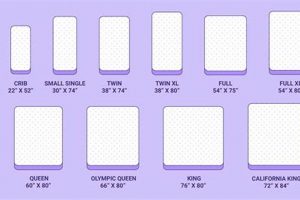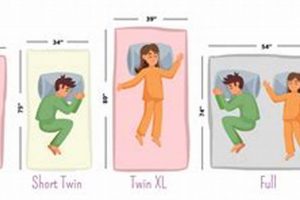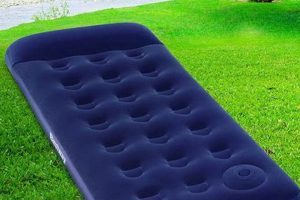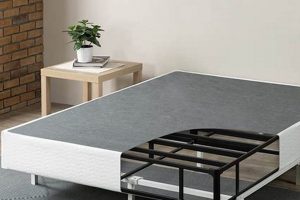A standard specification for beds found in student housing, it typically refers to a Twin XL. This elongated version of the standard single sleeping surface provides additional length, accommodating the generally taller stature of college-aged individuals. For example, a student may find the standard Twin insufficient, whereas the Twin XL offers improved comfort.
Understanding the precise dimensions is critical for incoming students. Accurate knowledge allows for the appropriate selection of bedding, including sheets, comforters, and mattress pads. Historically, institutions adopted this uniform specification to streamline logistical concerns, facilitate bulk purchasing, and ensure a degree of uniformity within residential spaces. This consistency simplifies the move-in process for students and their families.
The subsequent sections will delve into the specific measurements, common bedding options compatible with this standard, potential sources for acquiring appropriately sized linens, and strategies for maximizing comfort within the confines of a small living space. This information should prove invaluable for prospective and current residents.
Considerations for Bed Selection
The following points offer practical guidance for individuals preparing to outfit sleeping arrangements within dormitory settings, specifically concerning appropriately sized bedding and accessories.
Tip 1: Verify Dimensions. It is imperative to confirm the exact measurements of the provided sleeping surface before purchasing any bedding. While Twin XL is the most prevalent, variations can exist, particularly in older facilities.
Tip 2: Prioritize Fitted Sheets. Selecting correctly sized fitted sheets is crucial for a secure and comfortable fit. Ill-fitting sheets can lead to discomfort and require frequent readjustment.
Tip 3: Invest in a Mattress Pad. Dormitory-provided mattresses are often basic. A quality mattress pad can significantly enhance comfort and provide an additional layer of protection.
Tip 4: Opt for Washable Bedding. College environments are prone to spills and accidents. Choosing bedding that is easily laundered simplifies maintenance and hygiene.
Tip 5: Consider Bed Risers. Elevating the bedframe provides additional storage space beneath the sleeping surface, which is particularly beneficial in compact living quarters.
Tip 6: Evaluate Comforter Size. Ensure the chosen comforter or duvet adequately covers the sides of the bed. A comforter that is too small can appear aesthetically unappealing and provide insufficient warmth.
Tip 7: Protect Against Allergens. Individuals with allergies should consider hypoallergenic bedding to mitigate potential reactions to dust mites or other allergens commonly found in shared living spaces.
Adhering to these recommendations can promote improved sleep quality and overall well-being within the dormitory environment.
The concluding segment will summarize the essential aspects of procuring and maintaining appropriate bedding for student residences.
1. Twin XL standard
The term dorm room mattress size is intrinsically linked to the Twin XL standard. The latter effectively defines the former in the vast majority of academic residential settings across the United States. The cause-and-effect relationship is straightforward: the prevalence of smaller dormitory rooms necessitated a mattress size that balances individual comfort with spatial efficiency, leading to the widespread adoption of the Twin XL. Its dimensions, nominally 38 inches by 80 inches, offer six additional inches in length compared to a standard twin, accommodating taller students without significantly increasing the overall footprint of the bed within the room.
The importance of the Twin XL standard lies in its provision of a uniform and predictable variable. Colleges and universities utilize it for logistical efficiency in procurement and replacement of mattresses, as well as to allow families to anticipate and purchase bedding ahead of move-in day. For example, knowing that a students assigned room contains a Twin XL mattress allows the purchase of correctly-sized sheets and comforters well in advance, minimizing stress upon arrival. Without this standardization, students and their families would face uncertainty and potential difficulties in obtaining appropriate bedding within the limited timeframe of move-in.
In conclusion, the Twin XL standard serves as the foundational element in understanding dorm room mattress size. This understanding has practical implications, affecting decisions about bedding purchases, space organization, and overall comfort within the dorm environment. While exceptions may exist, the Twin XL dimension provides a reliable benchmark for students preparing for college residential life, simplifying a potentially complex and overwhelming process and offering a direct link to well-being during an important life transition.
2. 80 inches long
The measurement of 80 inches in length is a critical specification defining the dimensions of a typical dorm room mattress. This dimension directly impacts student comfort, particularly for those of above-average height, and influences the selection of appropriate bedding.
- Accommodating Taller Individuals
The 80-inch length provides adequate support for individuals exceeding six feet in height. Standard twin mattresses, lacking this additional length, can result in discomfort and disrupted sleep patterns. The elongation minimizes the likelihood of feet extending beyond the mattress edge, thereby promoting more restful sleep.
- Bedding Compatibility
Specific bedding sizes are required to properly fit mattresses of this dimension. Standard twin sheets are often insufficient, necessitating the purchase of “Twin XL” bedding. Failure to utilize appropriately sized linens can lead to ill-fitting sheets, increased wear and tear, and a compromised sleeping experience.
- Space Optimization in Dormitories
While longer than standard twin mattresses, the 80-inch length represents a compromise between student comfort and efficient space utilization in typically compact dormitory rooms. This length allows for adequate sleeping space without unduly encroaching upon the limited floor area available for other essential furnishings and activities.
- Standardization and Procurement
The adoption of the 80-inch length as a standard facilitates bulk purchasing and streamlined logistics for colleges and universities. Uniform mattress sizes simplify inventory management and reduce the complexity of outfitting dormitory rooms, allowing for economies of scale and greater efficiency in resource allocation.
The 80-inch dimension is an integral component of the standard dorm room mattress, directly affecting comfort, bedding selection, space management, and institutional procurement practices. Its prevalence underscores the importance of this specific measurement in ensuring a functional and comfortable living environment for students in residential settings.
3. 38 inches wide
The specification of 38 inches in width is a defining characteristic of the typical dorm room mattress, directly correlating with its designation as a Twin XL. This dimension represents a balance between providing adequate individual sleeping space and optimizing room layout within often-confined dormitory environments.
- Single Occupancy Accommodation
The 38-inch width is designed to comfortably accommodate a single occupant. This dimension is based on average shoulder width and allows for sufficient room to move during sleep without significant constraint. The selection of this width inherently restricts the mattress to single-person use, aligning with the common practice of individual student housing assignments.
- Space Efficiency in Dormitories
Given the limited square footage of most dorm rooms, the 38-inch width is a compromise between comfort and functionality. Wider mattresses would consume disproportionately more floor space, potentially restricting movement and limiting furniture options. This dimension permits reasonable aisle space and facilitates the arrangement of desks, dressers, and other essential items.
- Standardized Bedding and Accessories
The uniformity of the 38-inch width allows for the mass production and easy availability of appropriately sized bedding, including fitted sheets, mattress protectors, and comforters. This standardization simplifies the process for students and families to acquire necessary items, ensuring a proper fit and preventing the inconvenience of using ill-sized alternatives.
- Weight Distribution and Support
The 38-inch width is engineered to provide adequate support and weight distribution for a single individual. The internal mattress construction, including springs, foam, and other materials, is designed to maintain structural integrity and prevent sagging within this specific width. Exceeding the intended weight capacity can compromise the mattress’s lifespan and comfort.
In conclusion, the 38-inch width is a non-negotiable aspect of the typical dorm room mattress, directly influencing comfort, spatial efficiency, bedding availability, and structural integrity. It represents a deliberate design choice intended to optimize the dormitory living experience within inherent spatial constraints.
4. Sheet set compatibility
The phrase “sheet set compatibility” bears a direct and critical relationship to “dorm room mattress size.” A Twin XL mattress, the commonly encountered specification in student residences, demands similarly designated sheet sets. The dimensions of standard twin sheets are insufficient, leading to improper fit, potential tearing, and compromised comfort. For example, attempting to use standard twin fitted sheets on a Twin XL mattress results in inadequate coverage and detachment from the corners, thereby rendering the sheets ineffective. Conversely, correctly sized sheets ensure a snug fit, preventing movement during sleep and maximizing the lifespan of both the sheets and the mattress itself. Universities often provide size details to incoming students, underscoring the critical need to acquire the appropriate bedding ahead of the move-in process.
Beyond the immediate impact on comfort, “sheet set compatibility” has practical implications for hygiene and mattress protection. Properly fitted sheets act as a barrier against spills, stains, and allergens, thereby prolonging the life of the mattress and reducing the need for frequent cleaning. Ill-fitting sheets, in contrast, can bunch up and trap dirt and moisture, creating an environment conducive to microbial growth. For instance, a student using standard twin sheets on a Twin XL mattress might experience increased skin irritation due to direct contact with the mattress surface and the accumulation of dust mites within the improperly fitted bedding.
In summation, “sheet set compatibility” is not merely a matter of aesthetics; it is a fundamental requirement for comfort, hygiene, and the longevity of dorm room furnishings. Ensuring that sheet sets are appropriately sized for the Twin XL mattress is an essential step for students transitioning to residential life, with potential challenges arising from neglecting this requirement being readily mitigated through diligence and preparation.
5. Mattress pad thickness
The selection of a mattress pad for a dorm room often hinges on its thickness, a factor that influences comfort, support, and the overall fit with bedding designed for the standard Twin XL dorm room mattress size.
- Impact on Comfort and Support
Mattress pad thickness directly correlates with the level of cushioning and support provided. Thicker pads, typically ranging from 2 to 4 inches, offer enhanced pressure relief and can mitigate the firmness of older, less comfortable dorm room mattresses. Conversely, thinner pads, often less than 1 inch, provide minimal cushioning and primarily serve as a protective barrier against spills and stains.
- Influence on Sheet Fit
The thickness of the mattress pad affects the fit of fitted sheets designed for Twin XL mattresses. Thicker pads may require deep-pocket sheets to ensure adequate coverage and prevent the corners from slipping off. Using standard-pocket sheets with a thick pad can lead to a tight, stretched fit, potentially shortening the lifespan of the sheets.
- Consideration of Loft and Bed Height
In rooms where beds are lofted or bunked, mattress pad thickness can influence the overall height of the sleeping surface. An excessively thick pad may raise the mattress to a point where it compromises safety, particularly on upper bunks or in situations where the bed is already elevated on risers. Conversely, a thinner pad may be preferable in such circumstances to maintain a safe and accessible sleeping height.
- Effect on Mattress Protection
Regardless of thickness, a mattress pad serves as a protective layer, safeguarding the underlying mattress from spills, stains, allergens, and bed bugs. While thinner pads offer basic protection, thicker pads may provide more substantial coverage and absorption, particularly those with waterproof or hypoallergenic properties. This protection is essential for maintaining a clean and sanitary sleeping environment in shared dormitory settings.
Ultimately, the ideal mattress pad thickness for a dorm room mattress depends on individual preferences, budget constraints, and specific environmental considerations. Prioritizing comfort, proper sheet fit, safety, and mattress protection will guide the selection of an appropriate mattress pad to enhance the overall dormitory living experience.
6. Frame fit crucial
The necessity of a properly fitting frame is paramount when considering dorm room mattress size. The structural integrity and intended functionality of the sleeping surface are contingent upon compatible dimensions between the mattress and its supporting frame. This relationship extends beyond mere aesthetics, impacting safety, comfort, and the long-term preservation of the mattress itself.
- Support and Stability
A frame that is too large or too small relative to the mattress compromises its stability. An oversized frame allows for excessive mattress movement, leading to uneven wear and potential structural damage. A frame that is too small may not adequately support the mattress, resulting in sagging and discomfort. Proper frame fit ensures uniform weight distribution and maintains the integrity of the mattress’s internal components.
- Safety Considerations
An ill-fitting frame presents safety hazards. If the mattress is not securely seated within the frame, it may shift or fall, posing a risk of injury. This is particularly relevant in lofted bed configurations, where a dislodged mattress could result in a significant fall. A correctly sized frame provides a secure and stable platform, minimizing the risk of accidents.
- Bedding Performance
The performance of bedding accessories is directly linked to the frame-mattress relationship. A properly supported mattress allows sheets and mattress pads to fit snugly and remain securely in place. Conversely, a sagging or unstable mattress can cause bedding to bunch, slip, or tear, compromising comfort and hygiene.
- Longevity of Mattress
Consistent and adequate support from the frame is essential for extending the lifespan of the mattress. Uneven weight distribution caused by an improperly fitting frame accelerates wear and tear, leading to premature sagging and degradation of the mattress’s internal materials. A well-matched frame provides the necessary support to maintain the mattress’s shape and structural integrity over time.
These considerations collectively underscore the fundamental importance of frame fit in maximizing the benefits and minimizing the risks associated with dorm room mattress size. Attention to this detail not only enhances comfort and safety but also contributes to the long-term value and performance of the mattress and related bedding accessories.
Frequently Asked Questions
This section addresses common inquiries regarding dimensions, bedding, and related considerations pertinent to outfitting sleeping spaces within student residences.
Question 1: What precisely constitutes a “dorm room mattress size?”
The term generally refers to a Twin XL mattress, measuring approximately 38 inches wide and 80 inches long. This elongated version of the standard twin is common in student housing to accommodate taller individuals.
Question 2: Are standard twin sheets compatible with a dorm room mattress?
No. Standard twin sheets are insufficient. The additional length of the Twin XL requires specifically designated bedding.
Question 3: Is it necessary to acquire a mattress pad for a dorm room bed?
While not mandatory, a mattress pad is highly recommended. It enhances comfort, provides a protective barrier, and can extend the lifespan of the mattress.
Question 4: Can the university provide the exact dimensions of the assigned mattress?
Incoming students should contact the university’s housing department directly. Requesting specific measurements is advisable to ensure appropriate bedding procurement.
Question 5: How does mattress thickness influence bedding selection?
Greater mattress thickness necessitates deeper pocket fitted sheets. Failure to account for thickness may result in ill-fitting bedding.
Question 6: What are the advantages of using bed risers in conjunction with a dorm room mattress?
Bed risers elevate the bedframe, creating additional storage space beneath the sleeping surface. This is particularly beneficial in cramped dormitory environments.
Understanding these core aspects facilitates informed decision-making regarding bedding and accessories, ultimately contributing to improved comfort and functionality within student living spaces.
The subsequent section will transition to detailing available purchasing options for Twin XL bedding sets.
Conclusion
The preceding sections have comprehensively explored the dimensions and related considerations surrounding the dorm room mattress size. The ubiquitous Twin XL specification necessitates careful attention to bedding selection, mattress protection, and the influence of factors such as mattress pad thickness and frame compatibility. The standardization of this size across most institutions presents both advantages and challenges for students transitioning to residential life.
A thorough understanding of these dimensions and related considerations is critical to fostering a comfortable and functional living space. Accurate measurements, informed purchasing decisions, and proactive attention to bedding hygiene directly contribute to student well-being and academic success. Prioritizing these seemingly minor details can yield significant positive outcomes within the demanding environment of higher education.





![Best Coleman Queen Size Air Mattress [Guide] Organic & Natural Mattress Buyer’s Guide: Non-Toxic Sleep Solutions Best Coleman Queen Size Air Mattress [Guide] | Organic & Natural Mattress Buyer’s Guide: Non-Toxic Sleep Solutions](https://mattressworldpa.com/wp-content/uploads/2025/07/th-2264-300x200.jpg)

